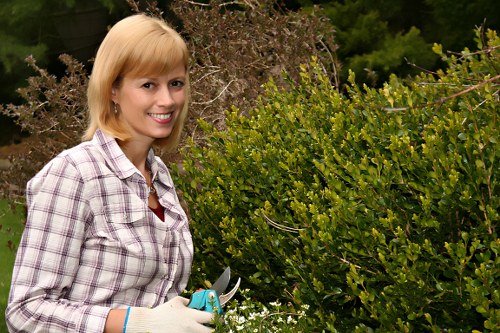Lawn Mowing Whetstone

Maintaining a beautiful lawn in Whetstone doesn't have to be a daunting task. With the right techniques and tools, you can keep your grass healthy and vibrant all year round. Whether you're a seasoned gardener or a beginner, understanding the essentials of lawn mowing can make a significant difference in the overall appearance of your outdoor space.
In this article, we will explore the best practices for lawn mowing in Whetstone, including choosing the right equipment, determining the optimal mowing height, and scheduling your mowing sessions. Additionally, we will discuss the unique features of the Whetstone area that influence lawn care strategies.
Before diving into the specifics, it's essential to understand the basics of lawn maintenance. A well-maintained lawn not only enhances the curb appeal of your home but also provides a safe and comfortable environment for outdoor activities. Proper lawn mowing is the foundation of effective lawn care, as it helps control weed growth, promote healthy grass, and even prevent pests.
Choosing the Right Lawn Mower

One of the first steps in maintaining your lawn is selecting the right mower. There are several types of lawn mowers available, each with its advantages and disadvantages. The most common types include push mowers, self-propelled mowers, and riding mowers.
Push Mowers: These are ideal for small to medium-sized lawns. They are affordable, easy to maneuver, and require minimal maintenance. Push mowers are also environmentally friendly, as they do not require gasoline or electricity.
Self-Propelled Mowers: Perfect for larger lawns, self-propelled mowers reduce the effort needed to push the machine. They are especially useful if your lawn has uneven terrain or many obstacles.
Electric vs. Gas-Powered Mowers

When choosing between electric and gas-powered mowers, consider the size of your lawn and your personal preferences. Electric mowers are quieter, produce no emissions, and are easier to maintain. However, they may have limited battery life and are best suited for smaller lawns.
Gas-powered mowers, on the other hand, offer more power and are better suited for larger areas. They can operate for longer periods without needing a recharge, but they require regular maintenance and produce more noise and emissions.
In Whetstone, where environmental consciousness is growing, electric mowers are becoming increasingly popular among homeowners looking for sustainable lawn care solutions.
Optimal Mowing Height

Setting the correct mowing height is crucial for maintaining a healthy lawn. The ideal height can vary depending on the type of grass you have. Generally, most lawns thrive when the grass is kept between 2.5 to 3.5 inches tall.
Cutting the grass too short can stress the plants, making them more susceptible to weeds, pests, and drought. On the other hand, allowing the grass to grow too long can lead to thatch buildup and other issues.
In Whetstone’s climate, which experiences a mix of warm summers and cool winters, maintaining the proper mowing height helps your lawn recover quickly from the seasonal changes and resist common lawn diseases.
Mowing Frequency

The frequency of mowing depends on the growth rate of your grass, which can be influenced by factors such as weather, soil quality, and fertilization. During the peak growing season, typically spring and summer, you may need to mow your lawn once a week.
In contrast, during the cooler months, grass growth slows down, and mowing can be reduced to every other week or even less frequently. Always ensure that you do not remove more than one-third of the grass blade height in a single mowing session to prevent stress on the plants.
Consistent mowing schedules help maintain an even grass height and promote a dense, healthy lawn that can better resist weeds and pests.
Local Whetstone Areas and Lawn Mowing Tips

Whetstone and its surrounding areas offer diverse environments for lawn care. Understanding the unique characteristics of each locality can help tailor your mowing practices for optimal results.
Here are some of the closest areas to Whetstone and specific lawn mowing tips for each:
- Hollingbury: Known for its spacious parks, ensure you mow in a pattern that complements the natural layout and avoids disturbing public green spaces.
- St. John's: With a mix of residential and commercial properties, focus on versatile mowing equipment that can handle different lawn sizes and types.
- South Park Hill: This area has slightly hilly terrain, so using a self-propelled mower can make the task easier and safer.
- Kiln Park: The well-maintained gardens here benefit from regular mowing schedules to keep lawns pristine and inviting.
- Astons: Consider drought-resistant grass varieties and mowing practices that conserve water, as this area experiences dry spells.
- Round Hill: With its mix of flat and sloped areas, adjusting mowing heights can help manage different grass growth patterns effectively.
- Beam Hill: Focus on aerating the lawn before mowing to improve soil health and grass resilience.
- Altrincham: Urban lawns in this area may benefit from compact mowers that can navigate tighter spaces and sidewalks.
- Salesbury: Rich soil in Salesbury allows for deeper root growth; ensure blades are sharp to prevent tearing the grass.
- Burtonwood: Heavy clay soils require mowers that can handle thicker grass and promote better drainage.
- Gorse Hill: In areas with high foot traffic, maintain a slightly higher grass length to cushion wear and tear.
- Moorside: Utilize mulching mowers to recycle grass clippings and enrich the soil naturally.
- Heaton Moor: Balanced fertilization and mowing schedules will keep lawns lush and vibrant in this residential area.
- Brooklands: Given the proximity to water bodies, ensure mowing practices prevent runoff and protect local waterways.
- Blackheath Shaded lawns in Blackheath require specialized mowing techniques to promote even grass growth.
Essential Lawn Mowing Tips

To achieve the best results in lawn mowing, consider the following tips:
- Keep Mower Blades Sharp: Dull blades can damage grass, leading to uneven cuts and making the lawn more vulnerable to disease.
- Mow When Dry: Mowing wet grass can cause clumping and uneven cutting. Wait until the grass is dry for a cleaner mow.
- Vary Mowing Patterns: Changing the direction of mowing each session prevents soil compaction and encourages grass to grow upright.
- Collect Clippings: Regularly removing grass clippings reduces thatch buildup and improves lawn health.
- Edge Regularly: Neaten the edges of your lawn to give it a well-maintained appearance and prevent grass from encroaching on sidewalks and flower beds.
Implementing these practices can significantly enhance the health and appearance of your lawn, making mowing a more efficient and enjoyable task.
In addition to these tips, being mindful of local weather patterns and seasonal changes in Whetstone can help you adjust your mowing schedule and techniques accordingly.
Seasonal Lawn Care

Each season brings its own challenges and opportunities for lawn care. Understanding how to adjust your mowing practices throughout the year can keep your lawn in top condition.
- Spring: Begin regular mowing as grass begins to grow. Apply a balanced fertilizer to promote healthy growth.
- Summer: Raise the mower height to help grass retain moisture. Water early in the morning to reduce evaporation.
- Fall: Continue mowing until growth slows. Rake leaves regularly to prevent them from smothering the lawn.
- Winter: Minimize mowing as grass growth slows. Clear debris to protect the lawn from harsh weather.
Common Lawn Mowing Mistakes to Avoid

Even with the best intentions, certain mistakes can hinder your lawn care efforts. Being aware of these common errors can help you maintain a healthier and more attractive lawn.
Mowing Too Short: Cutting the grass too short can weaken the plants, making them susceptible to weeds and diseases. Always follow the one-third rule to ensure you’re not removing more than a third of the grass blade.
Ignoring Blade Maintenance: Dull blades tear the grass instead of cutting it cleanly. Regularly sharpen your mower blades to ensure a precise cut.
Inconsistent Mowing Schedule: Irregular mowing can lead to uneven grass growth and make it harder to maintain a uniform lawn. Establish a consistent mowing routine that aligns with your lawn’s growth rate.
Proper Grass Disposal

How you deal with grass clippings can impact the health of your lawn. There are two primary methods: mulching and bagging.
- Mulching: Mulching mowers finely chop the grass clippings and return them to the lawn. This method recycles nutrients and helps retain soil moisture.
- Bagging: Bagging involves collecting grass clippings in a bag for disposal. While this method keeps the lawn looking neat, it removes valuable nutrients that could benefit the grass.
In Whetstone, mulching is often preferred as it supports sustainable lawn care practices by naturally enriching the soil.
Advanced Lawn Mowing Techniques

For those looking to take their lawn care to the next level, consider these advanced mowing techniques:
- Scalping: This involves mowing the lawn very short to remove old grass and promote new growth. It should be done sparingly, typically once a year in the early spring.
- Striping: Creating striped patterns can enhance the visual appeal of your lawn. This can be done by adjusting the mower’s direction with each pass.
- Zoning: Divide your lawn into zones based on grass type, sun exposure, and soil conditions. Mow each zone according to its specific needs.
These techniques can help you achieve a more professional and aesthetically pleasing lawn, setting your Whetstone property apart.
Experimenting with different mowing strategies allows you to customize your lawn care routine to better suit your specific environment and preferences.
Using Technology for Lawn Care

Modern technology offers innovative solutions to make lawn mowing easier and more efficient. From robotic mowers to smart irrigation systems, integrating technology into your lawn care routine can save time and improve results.
- Robotic Mowers: These automated devices can mow your lawn with minimal supervision, ensuring consistent cutting without the hassle.
- Smart Irrigation: Automated watering systems can adjust based on weather conditions, ensuring your lawn receives the right amount of moisture.
- Lawn Care Apps: Apps can help you schedule mowing, track maintenance tasks, and even diagnose lawn issues.
Incorporating these technologies can streamline your lawn care process, making it easier to maintain a healthy and attractive lawn throughout the year.
Eco-Friendly Lawn Mowing Practices

As environmental concerns grow, many homeowners in Whetstone are seeking eco-friendly lawn mowing practices. Here are some ways to make your lawn care routine more sustainable:
- Use Electric Mowers: Electric mowers produce fewer emissions and are quieter than their gas-powered counterparts.
- Mulch Grass Clippings: Letting grass clippings decompose naturally returns nutrients to the soil, reducing the need for chemical fertilizers.
- Choose Native Grass: Native grass species are well-adapted to the local climate and require less water and maintenance.
- Reduce Mowing Frequency: Allowing grass to grow slightly longer can help it retain moisture and shade the soil, reducing evaporation.
Adopting these practices not only benefits the environment but also contributes to a healthier and more resilient lawn.
Organic Lawn Care Solutions

Organic lawn care solutions offer a natural alternative to chemical fertilizers and pesticides. These methods focus on improving soil health and promoting natural grass resilience.
- Compost: Adding compost to your lawn improves soil structure and provides essential nutrients for grass growth.
- Natural Fertilizers: Organic fertilizers, such as bone meal and fish emulsion, provide a slow-release nutrient source for your lawn.
- Biological Pest Control: Introducing beneficial insects can help manage lawn pests without the need for harmful chemicals.
Integrating organic solutions into your lawn care routine can lead to a more sustainable and eco-friendly lawn maintenance approach.
Conclusion

Maintaining a lush and healthy lawn in Whetstone is achievable with the right knowledge and practices. By choosing the appropriate mowing equipment, adhering to optimal mowing heights, and following a consistent mowing schedule, you can enhance the beauty and functionality of your outdoor space.
Understanding the unique characteristics of Whetstone’s local areas allows you to tailor your lawn care strategies effectively. Incorporating advanced techniques and eco-friendly practices further elevates your lawn maintenance routine, ensuring a vibrant and sustainable lawn year-round.
Remember, a well-maintained lawn not only boosts your property's curb appeal but also provides a welcoming environment for family and friends to enjoy. Invest the time and effort into proper lawn mowing, and you’ll be rewarded with a beautiful, healthy landscape that stands out in the Whetstone community.
Frequently Asked Questions

1. How often should I mow my lawn in Whetstone?
During the peak growing seasons in spring and summer, it's recommended to mow your lawn once a week. In the cooler months, you can reduce mowing frequency to every other week or as needed.
2. What is the best time of day to mow the lawn?
The best time to mow your lawn is in the late morning or early afternoon when the grass is dry. Avoid mowing in the heat of the day or early morning when dew is present.
3. Should I water my lawn before or after mowing?
It's best to water your lawn before mowing if it’s dry. Mowing when the grass is slightly moist can make the process easier and result in a cleaner cut. However, avoid mowing when the lawn is saturated or wet from recent rain.
4. How can I prevent weeds from growing in my lawn?
Maintaining a healthy lawn through regular mowing, proper fertilization, and watering can naturally suppress weed growth. Additionally, applying pre-emergent herbicides in early spring can help prevent weeds from establishing.
5. What type of grass is best suited for Whetstone’s climate?
Cool-season grasses such as Kentucky bluegrass, perennial ryegrass, and fescues are well-suited for Whetstone’s climate. These varieties thrive in the temperate conditions and require less water and maintenance.